Sony DAV-DZ231, DAV-DZ230 User Manual

3-095-059-12(1)
DVD Home Theatre
System
Operating Instructions
DAV-DZ230/DZ231
©2007 Sony Corporation
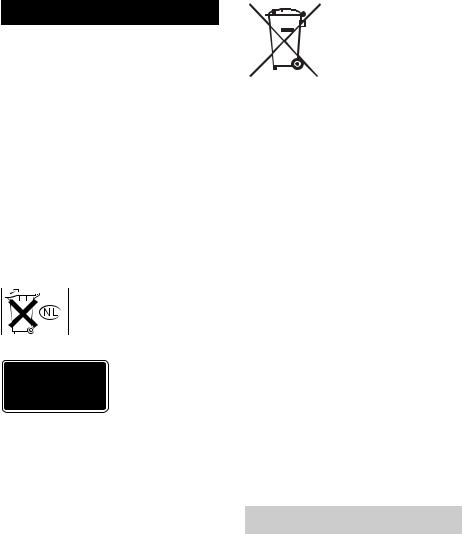
WARNING
To reduce the risk of fire or electric shock, do not expose this apparatus to rain or moisture.
Caution – The use of optical instruments with this product will increase eye hazard.
Do not install the appliance in a confined space, such as a bookcase or built-in cabinet.
To prevent fire, do not cover the ventilation of the apparatus with news papers, table-cloths, curtains, etc. And don’t place lighted candles on the apparatus.
To prevent fire or shock hazard, do not place objects filled with liquids, such as vases, on the apparatus. Do not expose the battery to excessive heat such as direct sunlight, fire, or the like.
Don’t throw away the battery with general house waste, dispose of it correctly as chemical waste.
This appliance is classified as a CLASS 1 LASER product. This marking is located on the rear exterior.
NOTICE FOR THE CUSTOMERS IN THE UNITED KINGDOM
A moulded plug complying with BS1363 is fitted to this equipment for your safety and convenience. Should the fuse in the plug supplied need to be replaced, a fuse of the same rating as the supplied one and approved by ASTA or BSI to BS1362, (i.e., marked with mark or
or mark) must be used.
mark) must be used.
If the plug supplied with this equipment has a detachable fuse cover, be sure to attach the fuse cover after you change the fuse. Never use the plug without the fuse cover.
If you should lose the fuse cover, please contact your nearest Sony service station.
Disposal of Old Electrical & Electronic Equipment (Applicable in the European Union and other European countries with separate collection systems)
 This symbol on the product or on its packaging indicates that this product shall not be treated as household waste. Instead
This symbol on the product or on its packaging indicates that this product shall not be treated as household waste. Instead
it shall be handed over to the applicable collection point for the recycling of electrical and electronic equipment. By ensuring this product is disposed of correctly, you will help prevent potential negative consequences for the environment and human health, which could otherwise be caused by inappropriate waste handling of this product. The recycling of materials will help to conserve natural resources. For more detailed information about recycling of this product, please contact your local Civic Office, your household waste disposal service or the shop where you purchased the product.
Precautions
On power sources
•AC power cord (mains lead) must be changed only at the qualified service shop.
•The unit is not disconnected from the AC power source (mains) as long as it is connected to the wall outlet (mains), even if the unit itself has been turned off.
•Install this system so that the AC power cord (mains) can be unplugged from the wall socket immediately in the event of trouble.
Welcome!
Thank you for purchasing Sony DVD Home Theatre System. Before operating this system, please read this manual thoroughly and retain it for future reference.
2GB

Table of Contents |
|
Welcome!................................................ |
2 |
About This Manual ................................. |
5 |
This System Can Play the Following |
|
Discs ................................................. |
6 |
Getting Started – BASIC – |
|
Step 1: Connecting the System and |
|
TV ............................................... |
9 |
Step 2: Positioning the System... |
13 |
Step 3: Performing the Quick |
|
Setup........................................ |
14 |
Getting Started |
|
– ADVANCED – |
|
Turning off the Demonstration ............. |
17 |
Installing the Speakers on a Wall.......... |
18 |
Connecting the TV (Advanced) ............ |
19 |
Connecting Other Components............. |
21 |
Basic Operations |
|
Playing Discs ................................ |
22 |
Enjoying the Radio or Other |
|
Components............................ |
23 |
Enjoying TV Sound from All |
|
Speakers.................................. |
24 |
Selecting the Movie or Music |
|
Mode ........................................ |
25 |
Sound Adjustments |
|
Enjoying Surround Sound by Using Sound |
|
Field ................................................ |
26 |
Various Functions for Playing |
|
Discs |
|
Searching for a Particular Point on |
|
a Disc .............................................. |
28 |
(Scan, Slow-motion Play, Freeze |
|
Frame) |
|
Searching for a Title/Chapter/Track/ |
|
Scene, etc. ....................................... |
29 |
Searching by Scene ............................... |
30 |
(Picture Navigation) |
|
Resuming Playback from the Point Where |
|
You Stopped the Disc ..................... |
30 |
(Resume Play) |
|
Creating Your Own Program ................ |
31 |
(Program Play) |
|
Playing in Random Order ..................... |
33 |
(Shuffle Play) |
|
Playing Repeatedly ............................... |
34 |
(Repeat Play) |
|
Using the DVD’s Menu........................ |
35 |
Changing the Sound.............................. |
35 |
Selecting [ORIGINAL] or [PLAY LIST] |
|
on a DVD-R/DVD-RW.................. |
37 |
Viewing Information About the Disc ... |
38 |
Changing the Angles ............................ |
40 |
Displaying the Subtitles........................ |
41 |
Adjusting the Delay Between the Picture |
|
and Sound....................................... |
41 |
(A/V SYNC) |
|
About MP3 Audio Tracks and JPEG |
|
Image Files ..................................... |
42 |
Playing DATA CDs or DATA DVDs with |
|
MP3 Audio Tracks and JPEG Image |
|
Files ................................................ |
44 |
Playing Audio Tracks and Images as a |
|
Slide Show with Sound .................. |
46 |
Enjoying DivX® Videos ...................... |
48 |
(Except for United Kingdom and |
|
North American models) |
|
Playing VIDEO CDs with PBC Functions |
|
(Ver.2.0) ......................................... |
50 |
(PBC Playback) |
|
Tuner Functions |
|
Presetting Radio Stations...................... |
51 |
Listening to the Radio........................... |
52 |
Using the Radio Data System (RDS) ... |
53 |
Other Operations |
|
Controlling the TV with the Supplied |
|
Remote ........................................... |
54 |
Using the THEATRE SYNC |
|
Function.......................................... |
54 |
Using the Sound Effect......................... |
55 |
Using the Sleep Timer .......................... |
56 |
Changing the Brightness of the Front |
|
Panel Display.................................. |
56 |
Using the DIGITAL MEDIA PORT |
|
Adapter ........................................... |
57 |
Deactivating the Buttons on the Unit ... |
58 |
(Child Lock) |
|
continued |
|
3GB
Advanced Settings and |
|
Adjustments |
|
Locking Discs ....................................... |
59 |
(CUSTOM PARENTAL |
|
CONTROL, PARENTAL |
|
CONTROL) |
|
Getting Optimal Surround Sound for a |
|
Room .............................................. |
62 |
(SPEAKER FORMATION) |
|
Calibrating the Appropriate Settings |
|
Automatically ................................. |
64 |
(AUTO CALIBRATION) |
|
Using the Setup Display........................ |
66 |
Setting the Display or Sound Track |
|
Language ........................................ |
68 |
[LANGUAGE SETUP] |
|
Settings for the Display......................... |
68 |
[SCREEN SETUP] |
|
Custom Settings .................................... |
70 |
[CUSTOM SETUP] |
|
Settings for the Speakers....................... |
71 |
[SPEAKER SETUP] |
|
Returning to the Default Settings.......... |
74 |
Additional Information |
|
Precautions............................................ |
75 |
Notes about the Discs............................ |
76 |
Troubleshooting .................................... |
76 |
Self-diagnosis Function ........................ |
80 |
(When letters/numbers appear in |
|
the display) |
|
Specifications........................................ |
81 |
Glossary ................................................ |
82 |
Language Code List .............................. |
85 |
Index to Parts and Controls................... |
86 |
Guide to the Control Menu Display...... |
88 |
DVD Setup Display List ....................... |
91 |
System Menu List ................................. |
92 |
Index ..................................................... |
93 |
4GB

About This Manual
•The instructions in this manual describe the controls on the remote. You can also use the controls on the unit if they have the same or similar names as those on the remote.
•The instructions in this manual are for DAVDZ230 and DAV-DZ231. DAV-DZ230 is the model used for illustration purposes. Any difference in operation is clearly indicated in the text, for example, “DAV-DZ230 only.”
•The Control Menu items may vary depending on the area.
•“DVD” may be used as a general term for DVD VIDEOs, DVD+RWs/DVD+Rs, and DVD-RWs/DVD-Rs.
•Measurements are expressed in feet (ft) for North American models.
•The following symbols are used in this manual.
Symbol Meaning
Functions available for DVD VIDEOs, DVD-Rs/DVD-RWs in video mode, and DVD+Rs/ DVD+RWs
Functions available for DVD-Rs/
DVD-RWs in VR (Video
Recording) mode
Functions available for VIDEO
CDs (including Super VCDs or CD-
Rs/CD-RWs in video CD format or
Super VCD format)
Functions available for music CDs or CD-Rs/CD-RWs in music CD format
Functions available for DATA CDs (CD-ROMs/CD-Rs/CD-RWs) containing MP31) audio tracks, JPEG image files, and DivX2)3)4) video files
Functions available for DATA DVDs (DVD-ROMs/DVD-Rs/ DVD-RWs/DVD+Rs/DVD+RWs) containing MP31) audio tracks, JPEG image files, and DivX2)3)4) video files
1)MP3 (MPEG1 Audio Layer 3) is a standard format defined by ISO/MPEG which compresses audio data.
2)Except for United Kingdom and North American models.
3)DivX® is a video file compression technology, developed by DivX, Inc.
4)DivX, DivX Certified, and associated logos are trademarks of DivX, Inc. and are used under license.
5GB
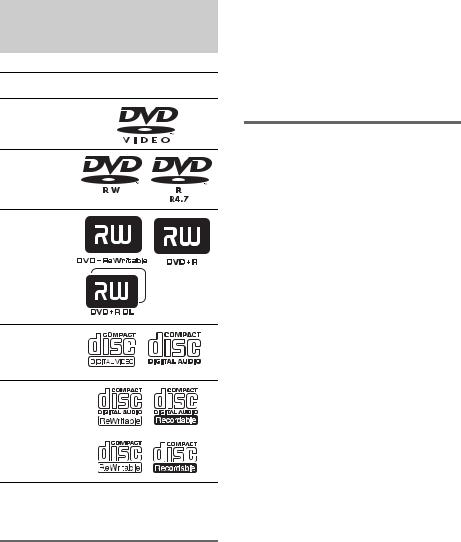
This System Can Play the
Following Discs
Format of
Disc logo
discs
DVD VIDEO
DVD-RW/
DVD-R
DVD+RW/
DVD+R
VIDEO CD (Ver. 1.1 and 2.0 discs)/ Audio CD
CD-RW/CD-R (audio data) (MP3 files) (JPEG files)
“DVD-RW,” “DVD+RW,” “DVD+R,”
“DVD VIDEO,” and the “CD” logos are trademarks.
Note about CDs/DVDs
The system can play CD-ROMs/CD-Rs/CD- RWs recorded in the following formats:
–audio CD format
–VIDEO CD format
–MP3 audio tracks, JPEG image files, and DivX video files* of format conforming to ISO 9660 Level 1/Level 2, or its extended format, Joliet
The system can play DVD-ROMs/DVD+RWs/ DVD-RWs/DVD+Rs/DVD-Rs recorded in the following formats:
–MP3 audio tracks, JPEG image files, and DivX video files* of format conforming to
UDF (Universal Disk Format)
*Except for United Kingdom and North American models.
Example of discs that the system cannot play
The system cannot play the following discs:
•CD-ROMs/CD-Rs/CD-RWs other than those recorded in the formats listed on page 6
•CD-ROMs recorded in PHOTO CD format
•Data part of CD-Extras
•DVD Audios
•Super Audio CD
•DATA DVDs that do not contain MP3 audio
tracks, JPEG image files, or DivX video files*
*Except for United Kingdom and North American models.
• DVD-RAMs
Also, the system cannot play the following discs:
•A DVD VIDEO with a different region code (page 7, 84)
•A disc that has a non-standard shape (e.g., card, heart)
•A disc with paper or stickers on it
•A disc that has the adhesive of cellophane tape or a sticker still left on it
Notes about CD-R/CD-RW/DVD-R/ DVD-RW/DVD+R/DVD+RW
In some cases, CD-R/CD-RW/DVD-R/DVD- RW/DVD+R/DVD+RW cannot be played on this system due to the recording quality or physical condition of the disc, or the characteristics of the recording device and authoring software.
The disc will not play if it has not been correctly finalized. For more information, see the operating instructions for the recording device. Note that some playback functions may not work with some DVD+RWs/DVD+Rs, even if they have been correctly finalized. In this case,
6GB

view the disc by normal playback. Also some DATA CDs/DATA DVDs created in Packet Write format cannot be played.
Music discs encoded with copyright protection technologies
This product is designed to play back discs that conform to the Compact Disc (CD) standard. Recently, various music discs encoded with copyright protection technologies are marketed by some record companies. Please be aware that among those discs, there are some that do not conform to the CD standard and may not be playable by this product.
Note on DualDiscs
A DualDisc is a two sided disc product which mates DVD recorded material on one side with digital audio material on the other side. However, since the audio material side does not conform to the Compact Disc (CD) standard, playback on this product is not guaranteed.
About Multi Session CD
•This system can play Multi Session CDs when an MP3 audio track is contained in the first session. Any subsequent MP3 audio tracks recorded in later sessions can also be played back.
•This system can play Multi Session CDs when a JPEG image file is contained in the first session. Any subsequent JPEG image files recorded in later sessions can also be played back.
•If audio tracks and images in music CD format or video CD format are recorded in the first session, only the first session will be played back.
Region code
Your system has a region code printed on the rear of the unit and will only play DVDs labeled with the same region code.
DVD VIDEOs labeled ALL will also play on this system.
If you try to play any other DVD VIDEO, the message [Playback prohibited by area limitations.] will appear on the TV screen. Depending on the DVD VIDEO, no region code indication may be given even though playing the DVD VIDEO is prohibited by area restrictions.
Note about playback operations of DVDs and VIDEO CDs
Some playback operations of DVDs and VIDEO CDs may be intentionally set by software producers. Since this system plays DVDs and VIDEO CDs according to the disc contents the software producers designed, some playback features may not be available. Be sure to read the operating instructions supplied with the DVDs or VIDEO CDs.
Copyrights
This product incorporates copyright protection technology that is protected by U.S. patents and other intellectual property rights. Use of this copyright protection technology must be authorized by Macrovision, and is intended for home and other limited viewing uses only unless otherwise authorized by Macrovision. Reverse engineering or disassembly is prohibited.
This system incorporates with Dolby* Digital and Dolby Pro Logic (II) adaptive matrix surround decoder and the DTS** Digital Surround System.
*Manufactured under license from Dolby Laboratories.
“Dolby”, “Pro Logic”, and the double-D symbol are trademarks of Dolby Laboratories.
**Manufactured under license from DTS, Inc. “DTS” and “DTS Digital Surround” are registered trademarks of DTS, Inc.
7GB
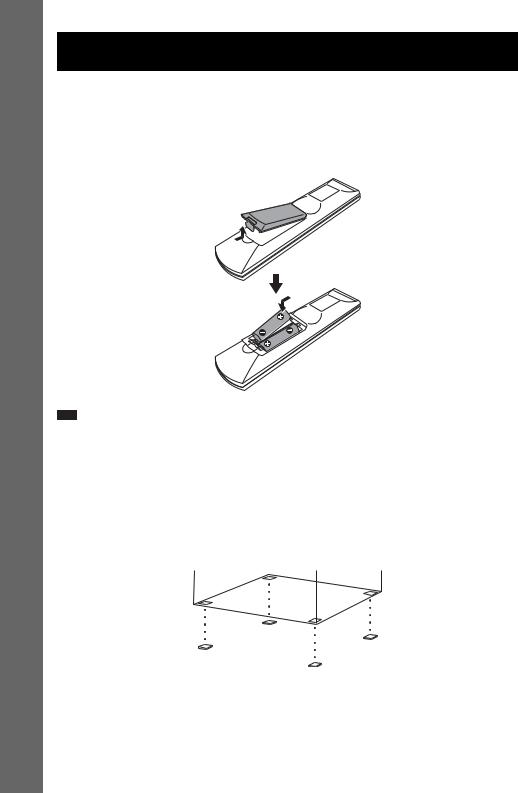
Getting Started – BASIC –
Getting Started – BASIC –
See Unpacking in Specifications, page 81.
Inserting batteries into the remote
You can control the system using the supplied remote. Insert two R6 (size AA) batteries by matching the 3 and # ends on the batteries to the markings inside the compartment. To use the remote, point it at the remote sensor  on the unit.
on the unit.
Note
•Do not leave the remote in an extremely hot or humid place.
•Do not use a new battery with an old one.
•Do not drop any foreign object into the remote casing, particularly when replacing the batteries.
•Do not expose the remote sensor to direct sunlight or lighting apparatus. Doing so may cause a malfunction.
•If you do not intend to use the remote for an extended period of time, remove the batteries to avoid possible damage from battery leakage and corrosion.
Attaching the foot pads to the subwoofer
Attach the supplied foot pads to the bottom of the subwoofer to stabilize the subwoofer and prevent it from slipping.
8GB
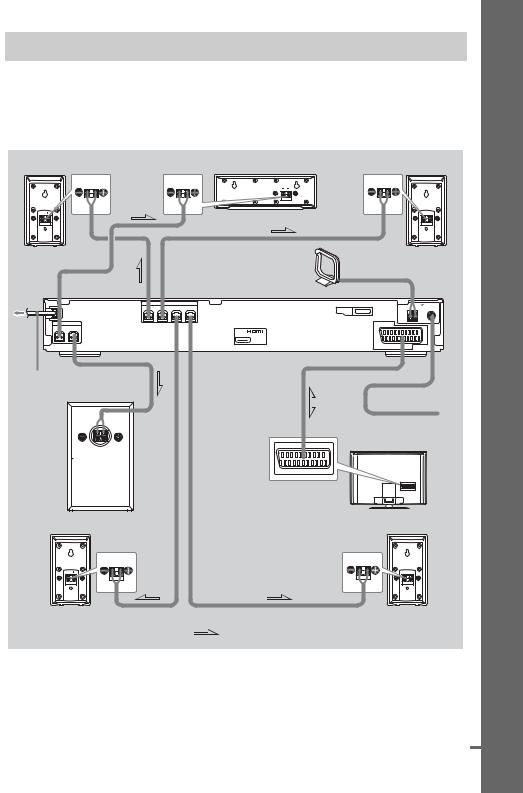
Step 1: Connecting the System and TV
The following is the basic connection of the unit to the speakers and TV. For other TV connections, see page 19. For other component connection, see page 21.
Refer to the connection diagram below, and read the additional information from 1 to 4 on the following pages.
Front speaker (R) |
|
Center speaker |
Front speaker (L) |
|||
|
|
|
|
|
|
|
|
|
|
|
|
|
|
|
|
|
|
|
|
|
AM loop antenna (aerial)
SPEAKER
FRONT R FRONT L SUR R |
SUR L |
|
AM |
COAXIAL |
DMPORT |
FM75 |
|||
|
|
|
|
|
SPEAKER |
|
|
EURO AV |
|
CENTER WOOFER |
|
|
|
|
OUT
(DVD ONLY)
 OUTPUT(TO TV)
OUTPUT(TO TV)
AC power cord (mains lead)
Subwoofer |
FM wire antenna (aerial)
TV
Surround speaker (R) |
Surround speaker (L) |
:Signal flow
continued
– BASIC – Started Getting
9GB
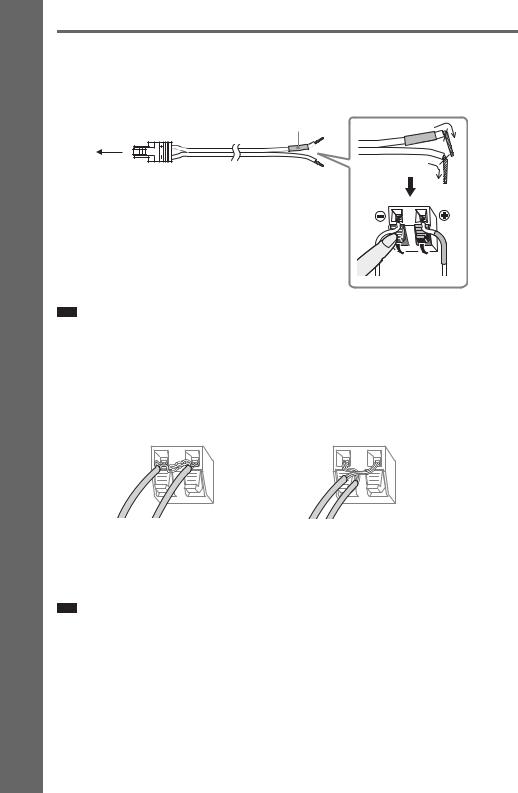
Getting Started – BASIC –
1 Connecting the Speakers
Required cords
The connector and color tube of the speaker cords are the same color as the label of the jacks to be connected.
Color tube
To the SPEAKER jack |
(+) |
|
|
|
(–) |
Note
• Do not catch the speaker cord insulation in the SPEAKER jack.
To avoid short-circuiting the speakers
Short-circuiting of the speakers may damage the system. To prevent this, be sure to follow these precautions when connecting the speakers. Make sure the bare wire of each speaker cord does not touch another speaker terminal or the bare wire of another speaker cord, such as shown below.
Stripped speaker cord is touching |
Stripped cords are touching each other |
||||||||
another speaker terminal. |
due to excessive removal of insulation. |
||||||||
|
|
|
|
|
|
|
|
|
|
|
|
|
|
|
|
|
|
|
|
After connecting all the components, speakers, and AC power cord (mains lead), output a test tone to check that all the speakers are connected correctly. For details on outputting a test tone, see page 73. If no sound is heard from a speaker while outputting a test tone, or a test tone is output from a speaker other than the one currently displayed on the Setup Display, the speaker may be short-circuited. If this happens, check the speaker connection again.
Note
•Be sure to match the speaker cord to the appropriate terminal on the components: 3 to 3, and # to #. If the cords are reversed, the sound will lack bass and may be distorted.
10GB
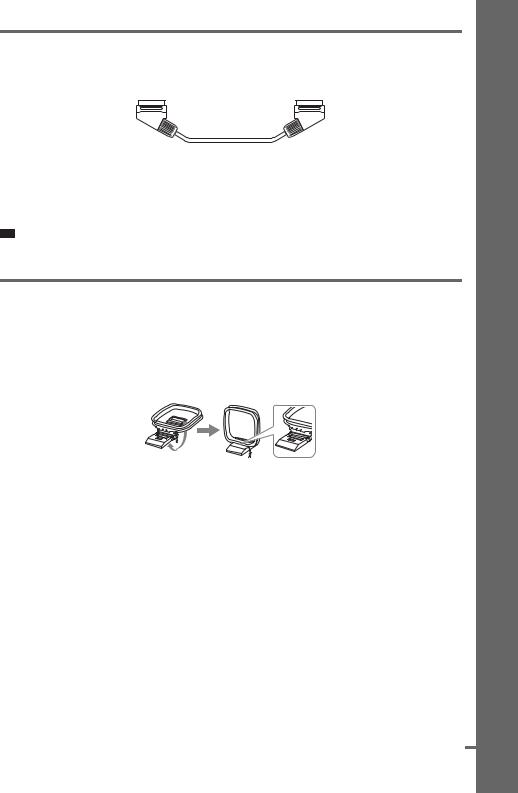
2 Connecting the TV
Required cords
SCART (EURO AV) cord (not supplied)
.
Be sure to connect the SCART (EURO AV) cord to the EURO AV T OUTPUT (TO TV) jack on the unit.
When you connect using the SCART (EURO AV) cord, check that the TV conforms to S video or RGB signals. If the TV conforms to S video, change the input mode of the TV to RGB signals. Refer to the operating instructions supplied with the TV to be connected.
Tip
•When you want to output the TV sound or stereo sound of a 2 channel source from the 6 speakers, select the “Dolby Pro Logic,” “Dolby Pro Logic II MOVIE,” or “Dolby Pro Logic II MUSIC” sound field (page 26).
3 Connecting the Antenna (Aerial)
To connect the AM loop antenna (aerial)
The shape and the length of the antenna (aerial) is designed to receive AM signals. Do not dismantle or roll up the antenna (aerial).
1 Remove only the loop part from the plastic stand.
2 Set up the AM loop antenna (aerial).
3 Connect the cords to the AM antenna (aerial) terminals.
Cord (A) or cord (B) can be connected to either terminal.
continued
– BASIC – Started Getting
11GB
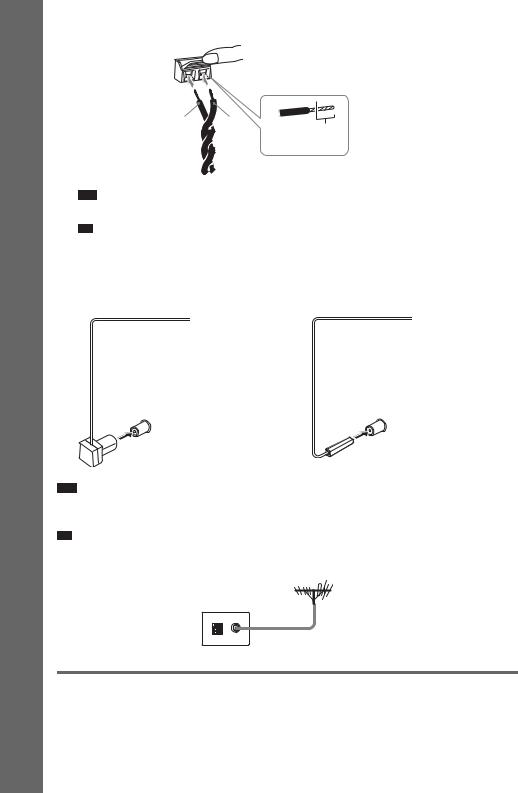
Getting Started – BASIC –
Insert the cord pushing down the terminal clamp.
A B
Insert until this part.
Note
• Do not place the AM loop antenna (aerial) near the unit or other AV equipment, as noise may result.
Tip
• Adjust the direction of the AM loop antenna (aerial) for best AM broadcast sound.
4 Make sure the AM loop antenna (aerial) is connected firmly by pulling softly.
To connect the FM wire antenna (aerial)
Connect the FM wire antenna (aerial) to the COAXIAL FM 75 Ω jack.
FM wire antenna (aerial) |
FM wire antenna (aerial) |
(supplied) |
(supplied) |
|
or |
COAXIAL FM 75 Ω jack |
COAXIAL FM 75 Ω jack |
Note
•Be sure to fully extend the FM wire antenna (aerial).
•After connecting the FM wire antenna (aerial), keep it as horizontal as possible.
Tip
•If you have poor FM reception, use a 75-ohm coaxial cable (not supplied) to connect the unit to an outdoor FM antenna (aerial) as shown below.
Unit
Outdoor FM antenna (aerial)
4 Connecting the AC power cord (mains lead)
Before connecting the AC power cord (mains lead) of this unit to a wall outlet (mains), connect the speakers to the unit.
12GB
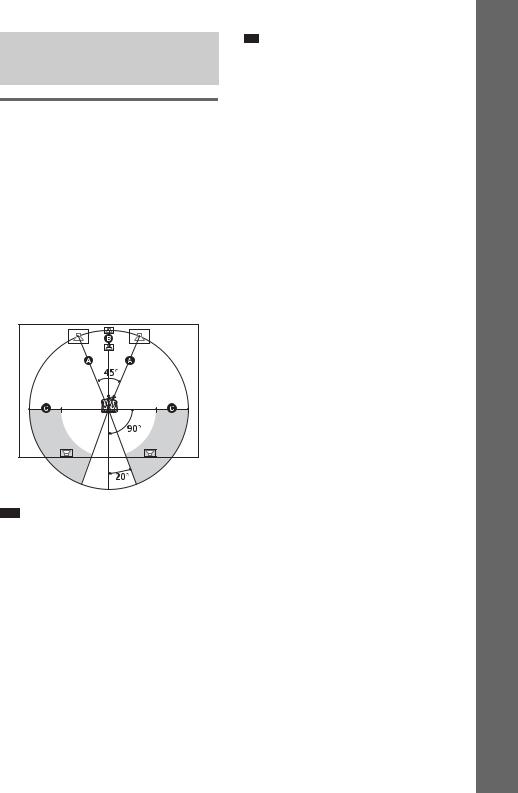
Step 2: Positioning the
System
Positioning the speakers
For the best possible surround sound, all the speakers other than the subwoofer should be placed at the same distance from the listening position (A).
However, this system allows you to place the center speaker up to 1.6 meters (5 ft) closer (B) and the surround speakers up to 5.0 meters (16 ft) closer (C) to the listening position.
The front speakers can be placed from 1.0 to 7.0 meters (3 to 23 ft) (A) from the listening position.
Place speakers as illustrated below.
Note
•Do not set the speakers in an inclined position.
•Do not place the speakers in locations that are:
–Extremely hot or cold
–Dusty or dirty
–Very humid
–Subject to vibrations
–Subject to direct sunlight
•When cleaning, use a soft cloth such as a cleaning cloth for glasses.
•Do not use any type of abrasive pad, scouring powder, or solvent such as alcohol or benzine.
Tip
•When you change the positions of the speakers, it is recommended that you change the settings. For details, see “Getting Optimal Surround Sound for a Room” (page 62) and “Calibrating the Appropriate Settings Automatically” (page 64).
– BASIC – Started Getting
13GB
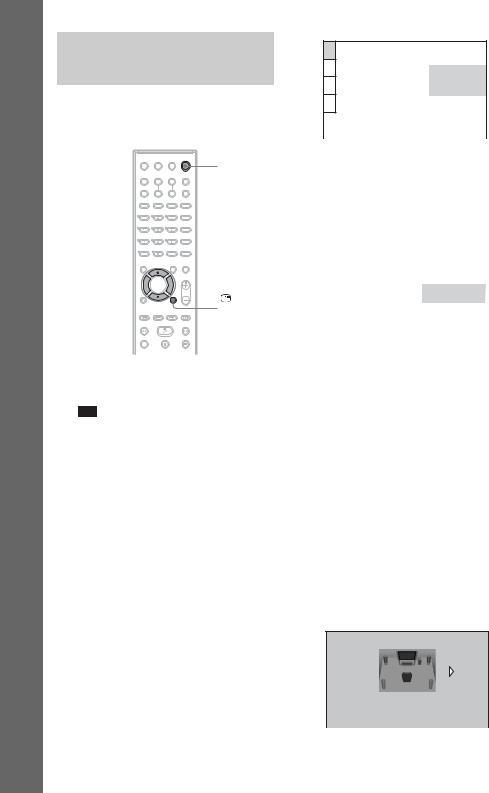
Getting Started – BASIC –
Step 3: Performing the
Quick Setup
Follow the steps below to make the minimum number of basic adjustments for using the system.
"/1
C/X/x/c, 




DISPLAY
1 Turn on the TV.
2 Press [/1.
Note
•Disconnect the headphones when you perform the Quick Setup. You cannot operate steps after 11 with the headphones connected.
•Make sure that the function is set to “DVD” (page 22).
3 Switch the input selector on your TV so that the signal from the system appears on the TV screen.
[Press [ENTER] to run QUICK SETUP.] appears at the bottom of the TV screen. If this message does not appear, recall the Quick Setup display (page 15) and perform again.
4 Press  without inserting a disc.
without inserting a disc.
The Setup Display for selecting the language used in the on-screen display appears.
LANGUAGE SETUP
|
|
OSD: |
ENGLISH |
|
|
MENU: |
ENGLISH |
|
|
AUDIO: |
FRENCH |
|
|
SUBTITLE: |
SPANISH |
|
|
|
PORTUGUESE |
|
|
|
|
5 Press X/x to select a language.
The system displays the menu and subtitles in the selected language.
6 Press  .
.
The Setup Display for selecting the aspect ratio of the TV to be connected appears.
|
SCREEN SETUP |
|
|
|
|
TV TYPE: |
16:9 |
|
|
YCBCR/RGB (HDMI): |
16:9 |
|
|
SCREEN SAVER: |
4:3 LETTER BOX |
|
|
BACKGROUND: |
4:3 PAN SCAN |
|
|
|
|
|
|
|
|
|
|
|
|
7 Press X/x to select the setting that matches your TV type.
xIf you have a wide-screen TV or a 4:3 standard TV with a wide-screen mode
[16:9] (page 68)
xIf you have a 4:3 standard TV
[4:3 LETTER BOX] or [4:3 PAN SCAN] (page 68)
8 Press  .
.
The Setup Display for selecting the speaker formation appears.
9 Press C/c to select the speaker formation image as the speakers are actually positioned.
For details, see “Getting Optimal Surround Sound for a Room” (page 62).
SPEAKER FORMATION
STANDARD
14GB
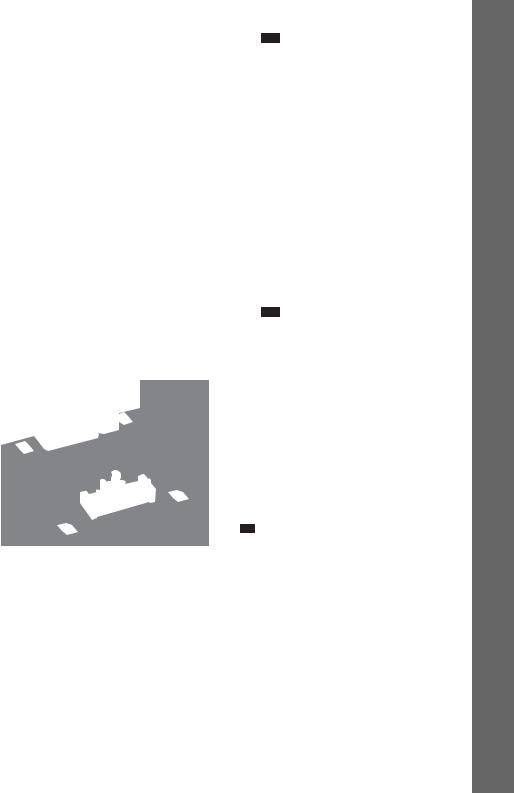
10 Press  .
.
11 Connect the calibration mic to the A.CAL MIC jack on the front panel and press X/x to select [YES].
Set up the calibration mic at the ear level using a tripod, etc. (not supplied). The front of each speaker should face the calibration mic, and there should be no obstruction between the speakers and the calibration mic. Be quiet during the measurement.
AUDIO IN / A.CAL MIC
Calibration mic
12 Press .
.
AUTO CALIBRATION
Connect calibration mic. Start measurement?
YES
NO
Auto Calibration starts.
Note
•Loud test sound is output when [AUTO CALIBRATION] starts. You cannot turn the volume down. Give consideration to children and neighbor.
•Avoid being in the measurement area and making noise during the measurement (which takes about 3 minutes), as it may interfere with measurement.
13 Unplug the calibration mic and press C/ c to select [YES].
Measurement complete.
FRONT L : |
YES |
FRONT R : |
YES |
CENTER : |
NONE |
SUBWOOFER : |
YES |
SURROUND L : |
NONE |
SURROUND R : NONE
If OK, unplug calibration mic and select
“YES”. |
YES |
NO |
|
Note
•The environment of the room in which the system is installed may affect measurements.
•If measurement fails, follow the message then retry [AUTO CALIBRATION].
•When you select [SECOND ROOM] for [SPEAKER FORMATION], measurement of [SURROUND L] and [SURROUND R] is not displayed.
14 Press  .
.
Quick Setup is finished. All connections and setup operations are complete.
To quit the Quick Setup
Press  DISPLAY in any Step.
DISPLAY in any Step.
Tip
•If you change the position of the speakers, reset the speaker settings. See “Getting Optimal Surround Sound for a Room” (page 62) and “Calibrating the Appropriate Settings Automatically” (page 64).
•If you want to change any of the settings, see “Using the Setup Display” (page 66).
To recall the Quick Setup display
1Press  DISPLAY when the system is in stop mode.
DISPLAY when the system is in stop mode.
The Control Menu display appears.
2Press X/x to select  [SETUP], then press
[SETUP], then press  .
.
The options for [SETUP] appear.
continued
– BASIC – Started Getting
15GB
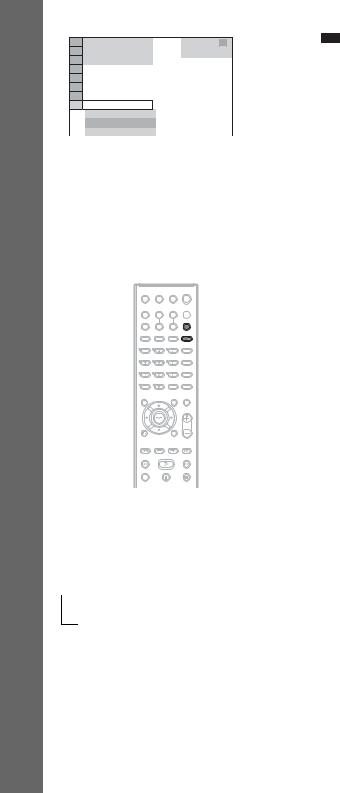
Getting Started – BASIC –
1 2 ( 2 7 ) |
|
|
1 8 ( 3 4 ) |
DVD VIDEO |
|
T |
0 : 0 0 : 0 2 |
|
QUICK |
|
|
QUICK |
|
|
CUSTOM |
|
|
RESET |
|
|
BNR |
|
|
3Press X/x to select [QUICK], then press  .
.
The Quick Setup display appears.
Selecting the output method for video signals
Selects the output method for video signals from the EURO AV T OUTPUT (TO TV) jack on the rear panel of the unit.
 FUNCTION
FUNCTION
 VIDEO
VIDEO
FORMAT
1 Press FUNCTION repeatedly to select “DVD.”
2 Press VIDEO FORMAT.
Each time you press VIDEO FORMAT, the display changes as follows:
t LINE VIDEO r
LINE RGB
•“LINE VIDEO”: outputs video signals.
•“LINE RGB”: outputs RGB signals.
Note
•If your TV does not accept RGB signals, no picture appears on the TV screen even if you select “LINE RGB.” Refer to the operating instructions supplied with your TV.
16GB
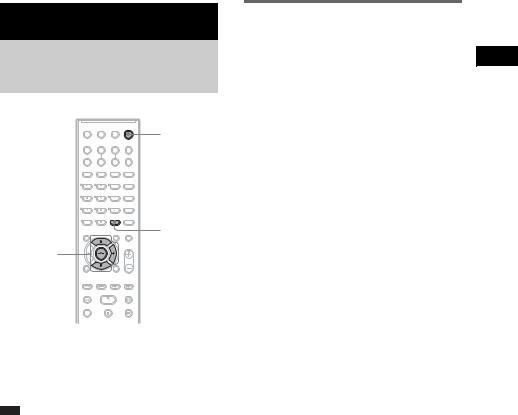
Getting Started – ADVANCED –
Turning off the
Demonstration
"/1
SYSTEM MENU
X/x/c, 
Setting the demonstration mode to on/off
1 Press SYSTEM MENU.
2 Press X/x repeatedly until “DEMO” appears in the front panel display, then press  or c.
or c.
3 Press X/x to select a setting.
The default setting is underlined.
•“DEMO ON”: sets the demonstration mode to on.
•“DEMO OFF”: sets the demonstration mode to off.
4 Press  .
.
The setting is made.
5 Press SYSTEM MENU.
The system menu turns off.
– ADVANCED – Started Getting
After connecting the AC power cord (mains lead), the demonstration appears in the front panel display. When you press "/1 on the remote, the demonstration turns off.
Note
•When you press "/1 on the unit, the demonstration does not turn off.
•When you set the demonstration mode in the system menu to on, the demonstration does not turn off even though you press "/1 on the remote. To turn off the demonstration, set the demonstration mode to off, then press "/1 on the remote. When the demonstration mode is set to off, the system saves power in standby mode.
•If the system is at its factory default settings (ex. after performing “COLD RESET” (page 74)), you can turn off the demonstration simply by pressing "/1 on the remote. Otherwise, to stop the demonstration, you need to set “DEMO” to “DEMO OFF.”
17GB
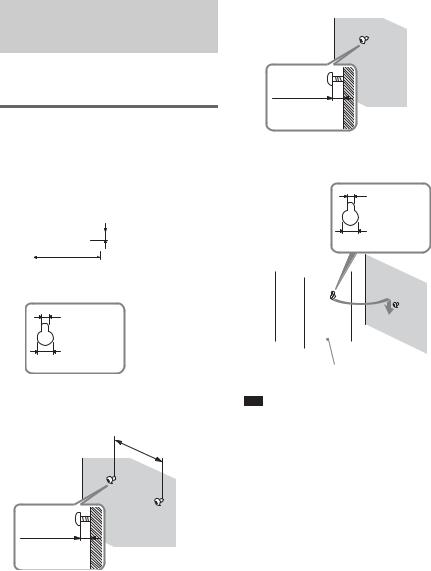
Installing the Speakers on a Wall
You can use the speakers by installing on the wall.
Installing the speakers on a wall
1 Prepare screws (not supplied) that are suitable for the hole on the back of each speaker. See the illustrations below.


 4 mm (5/32 inch)
4 mm (5/32 inch)
30 mm (1 3/16 inches)
Hole on the back of
43.6 mm the speaker ( /16 inch)
10 mm (13/32 inch)
2 Fasten the screws to the wall.
For the center speaker
160 mm
(6 5/16 inches)
7 to 9 mm (9/32 to 3/8 inch)
For the other speakers
6 to 9 mm (1/4 to 3/8 inch)
3 Hang the speakers on the screws.
4.6 mm (3/16 inch)
10 mm (13/32 inch)
Rear of speaker
Note
•Use screws that are suitable for the wall material and strength. As a plaster board wall is especially fragile, attach the screws securely to a beam and fasten them to the wall. Install the speakers on a vertical and flat wall where reinforcement is applied.
•Contact a screw shop or installer regarding the wall material or screws to be used.
•Sony is not responsible for accident or damage caused by improper installation, insufficient wall strength or improper screw installation, natural calamity, etc.
18GB

Connecting the TV (Advanced)
Sends the played back DVD image to the connected TV.
Check the jacks of your TV, and choose connection method Aor B. Picture quality improves in order from A (standard) to B (HDMI).
SPEAKER
FRONT R FRONT L SUR R |
SUR L |
|
AM |
COAXIAL |
DMPORT |
FM75 |
|||
|
|
|
|
|
SPEAKER |
|
|
EURO AV |
|
CENTER WOOFER |
|
|
|
|
|
|
OUT |
|
|
|
|
(DVD ONLY) |
|
|
|
|
|
OUTPUT(TO TV) |
|
|
To HDMI* OUT |
To EURO AV |
|
|
|
|
|
T OUTPUT |
|
|
(TO TV) |
B |
|
A |

 IN
IN
– ADVANCED – Started Getting
TV with HDMI* IN jack |
TV with EURO AV INPUT jack |
 :Signal flow
:Signal flow
*HDMI (high-definition multimedia interface)
The system incorporates High-Definition Multimedia Interface (HDMITM) technology.
HDMI, the HDMI logo and High-Definition Multimedia Interface are trademarks or registered trademarks of HDMI Licensing LLC.
Note
•When you connect the system and TV with the HDMI cord and the SCART (EURO AV) cord simultaneously, the TV may be set to SCART (EURO AV) input automatically. In this case, set to the desired input source on the TV, or use a SCART (EURO AV) cord that has separate audio connectors.
A To connect to a TV with the SCART (EURO AV) cord (not supplied)
.
Be sure to connect the SCART (EURO AV) cord to the EURO AV T OUTPUT (TO TV) jack on the unit.
When you connect using the SCART (EURO AV) cord, check that the TV conforms to S video or RGB signals. If the TV conforms to S video, change the input mode of the TV to RGB signals. Refer to the operating instructions supplied with the TV to be connected.
continued
19GB
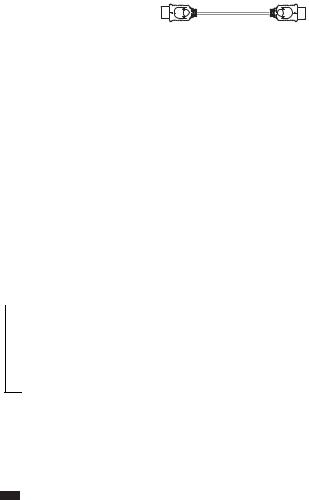
B To connect to a TV with the HDMI (high-definition multimedia interface)/DVI (digital visual interface) IN jack
Use a certified HDMI (high-definition multimedia interface) cord (not supplied) to enjoy high quality digital picture and sound through the HDMI OUT (high-definition multimedia interface out) jack.
To connect to a TV with DVI (digital visual interface) input
Use an HDMI (high-definition multimedia interface)-DVI (digital visual interface) converter cord (not supplied) with an HDMI (high-definition multimedia interface)-DVI (digital visual interface) adaptor (not supplied). The DVI (digital visual interface) jack will not accept any audio signals. Furthermore, you cannot connect the HDMI OUT (high-definition multimedia interface out) jack to DVI (digital visual interface) jacks that are not HDCP (high-bandwidth digital content protection) compliant (e.g., DVI (digital visual interface) jacks on the computer displays).
To select the type of video signal output from the HDMI OUT (highdefinition multimedia interface out) jack
When you connect the unit and the TV with the HDMI cord, selects the type of video signals output from the HDMI OUT (high-definition multimedia interface out) jack.
For details, refer also to the operating instructions supplied with the TV/projector, etc.
1
2
Press FUNCTION repeatedly to select “DVD.”
Press VIDEO FORMAT.
The current type of video signals appears in the front panel display.
Each time you press VIDEO FORMAT, the display changes as follows:
t 720 × 480p* r
1280 × 720p* r
720 × 480p* r
1920 × 1080i*
•“720 × 480p*”: Sends 720 × 480p video signals.**
•“1280 × 720p*”: Sends 1280 × 720p video signals.
•“1920 × 1080i*”: Sends 1920 × 1080i video signals.
*i: interlace, p: progressive
**Depending on the country, [720 × 576p] may appear.
Note
•When the HDMI indicator on the front panel lights up, images other than [720 × 480p] or [720 × 576p] are stretched vertically.
When connecting to a standard 4:3 screen TV
Depending on the disc, the image may not fit your TV screen.
To change the aspect ratio, see page 68.
20GB
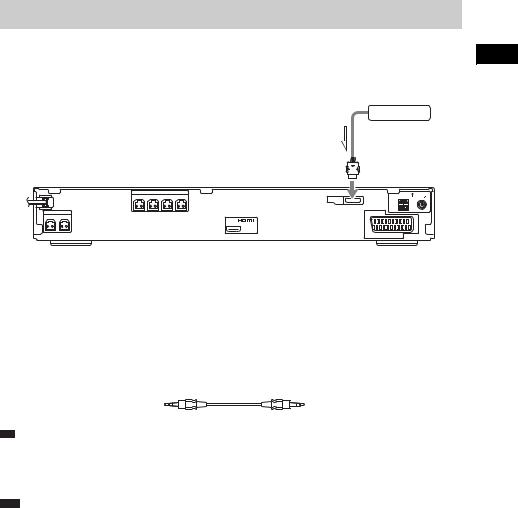
Connecting Other Components
You can enjoy sound using the speakers of this system by connecting the AUDIO OUT jacks of another component.
DIGITAL MEDIA
PORT adapter
To DMPORT jack
SPEAKER
FRONT R FRONT L SUR R |
SUR L |
|
AM |
COAXIAL |
DMPORT |
FM75 |
|||
|
|
|
|
|
SPEAKER |
|
|
EURO AV |
|
CENTER WOOFER |
|
|
|
|
OUT
(DVD ONLY)
 OUTPUT(TO TV)
OUTPUT(TO TV)
 :Signal flow
:Signal flow
To connect the DIGITAL MEDIA PORT adapter
Connect a DIGITAL MEDIA PORT adapter (not supplied) to the DMPORT jack. For details of the DIGITAL MEDIA PORT adapter, see “Using the DIGITAL MEDIA PORT Adapter” (page 57).
To listen to the portable audio source sound through the system
Connect the audio output jacks of the portable audio source to the AUDIO IN jack on the front panel of the unit with the stereo mini-plug cord (not supplied).
Tip
•When listening to MP3 format recordings using a portable audio source, you can enhance the sound.
Press FUNCTION to select “AUDIO.” Connect the portable audio source. Press SOUND FIELD repeatedly until “A.F.D. STD” appears in the front panel display.
To cancel, select other than “A.F.D. STD.”
Note
•Be sure to make connections securely to avoid hum and noise.
•When you connect another component with a volume control, turn up the volume of the other components to a level where sound is not distorted.
– ADVANCED – Started Getting
21GB
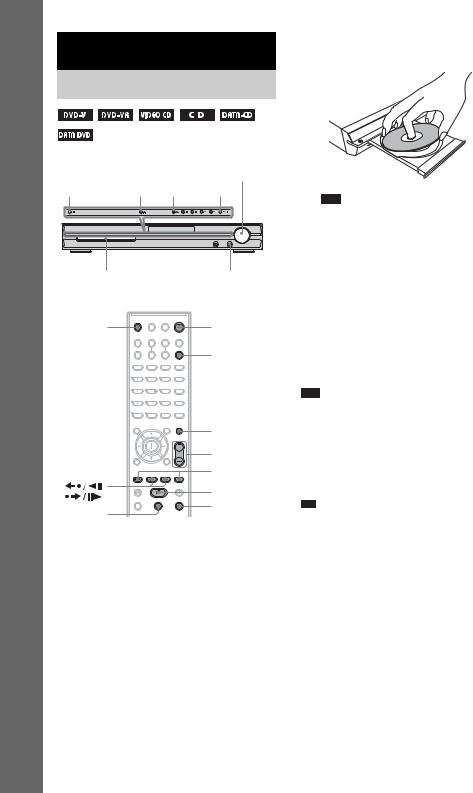
5 Load a disc.
Place one disc on the tray, and then press A.
Basic Operations
Playing Discs
BasicOperations |
|
|
Adjust the |
|
|
volume |
|
"/1 |
A |
H FUNCTION |
|
|
|
|
|
|
|
Disc tray |
Connect |
|
|
|
headphones |
|
|
Z |
"/1 |
|
|
|
FUNCTION |
|
|
|
MUTING |
|
|
|
VOLUME +/– |
|
|
|
./> |
|
|
/ |
H |
|
|
|
|
|
|
|
x |
|
|
X |
|
Depending on the DVD VIDEO or VIDEO CD, some operations may be different or restricted. Refer to the operating instructions supplied with your disc.
1 Turn on your TV.
2 Switch the input selector on the TV to this system.
3 Press "/1.
The system turns on.
Unless the system is set to “DVD,” press FUNCTION to select “DVD.”
4 Press A.
Note
•When you play an 8 cm disc, place it on the inner circle of the tray. Be careful that the disc is not skewed on the inner circle of the tray.
•Do not forcibly press the disc tray closed with your finger, as this may cause malfunction.
•Do not place more than one disc on the tray.
6 Press H.
The system starts playback (continuous play).
Adjust the volume on the unit.
The volume level appears on the TV screen and in the front panel display.
Note
•Depending on the system status, the volume level may not appear on the TV screen.
•When you set the HDMI CONTROL function to on (page 70), the TV that is connected to the system with the HDMI cord can be synch-operated with the system. For details, see the HDMI CONTROL Guide (supplied separately).
Tip
•When you connect the system and TV with the HDMI cord, you can operate them simply, using the HDMI CONTROL function. For details, see the HDMI CONTROL Guide (supplied separately).
To save the power in standby mode
Press "/1 while the system turns on. To cancel standby mode, press "/1 once.
22GB
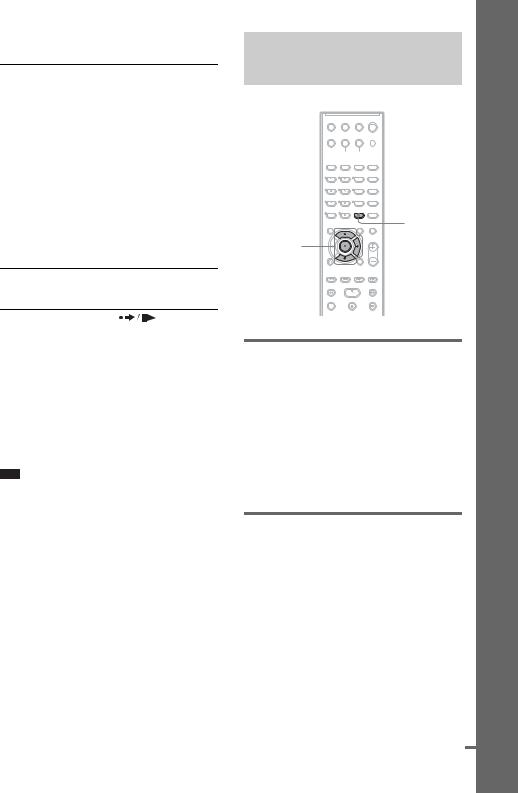
Additional operations
To |
Press |
Stop |
x |
|
|
Pause |
X |
|
|
Resume play after pause |
X or H |
|
|
Go to the next chapter, |
> (except for JPEG) |
track, or scene |
|
|
|
Go back to the preceding |
. (except for JPEG) |
chapter, track, or scene |
|
|
|
Turn off the sound |
MUTING. To cancel, |
temporarily |
press it again or |
|
VOLUME + to adjust |
|
the sound volume. |
|
|
Stop play and remove the |
Z on the remote or A |
disc |
on the unit. |
Replay the previous scene* 
 (instant replay) during playback.
(instant replay) during playback.
Briefly fast forward the |
(instant |
current scene** |
advance) during |
|
playback. |
|
|
*DVD VIDEOs/DVD-RWs/DVD-Rs only. The button can be used except for DivX video files (except for United Kingdom and North American models).
**DVD VIDEOs/DVD-RWs/DVD-Rs/DVD+RWs/ DVD+Rs only. The button can be used except for DivX video files (except for United Kingdom and North American models).
Note
•You may not be able to use the instant replay or instant advance function with some scenes.
Enjoying the Radio or Other Components


 FUNCTION
FUNCTION
SYSTEM MENU
X/x/c, 
Selecting the connected component
Press FUNCTION repeatedly until the desired function name appears in the front panel display.
Each time you press FUNCTION, the mode of the system changes in the following sequence.
DVD t TUNER FM t TUNER AM t TV t DMPORT t AUDIO t …
Changing the input level of the sound from connected components
Distortion may occur when listening to a TV connected to the EURO AV T OUTPUT (TO TV) jack on the rear panel or a component connected to the AUDIO IN jack on the front panel. This is not a malfunction and will depend on the component connected.
To prevent this, you can change the input level from the sound of the other components.
1 Press FUNCTION repeatedly until “TV” or “AUDIO” appears in the front panel display.
continued
Operations Basic
23GB
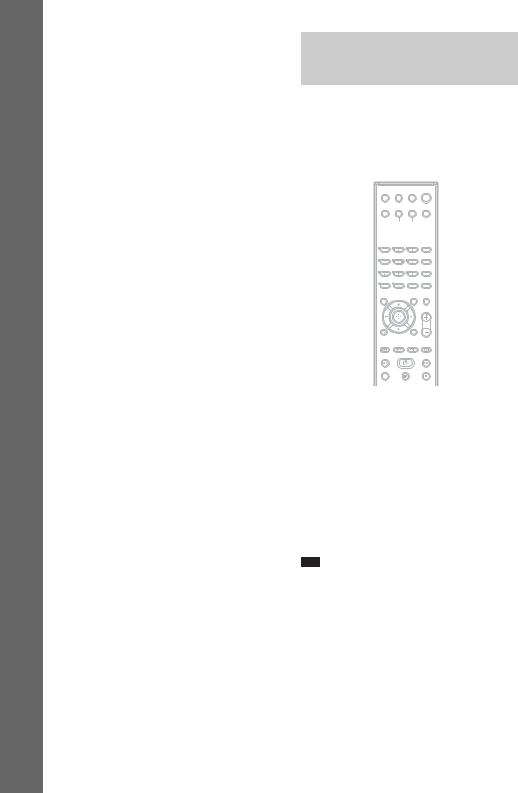
Basic Operations
2
3
4
5
6
Press SYSTEM MENU.
Press X/x repeatedly until
“ATTENUATE” appears in the front panel display, then press  or c.
or c.
Press X/x to select a setting.
The default setting is underlined.
•“ATT ON”: attenuates the input level. The output level is changed.
•“ATT OFF”: normal input level.
Press  .
.
The setting is made.
Press SYSTEM MENU.
The system menu turns off.
Enjoying TV Sound from All Speakers
You can enjoy TV sound from all the speakers in this system.
For details, see “Step 1: Connecting the System and TV” (page 9) and “Connecting the TV (Advanced)” (page 19).


 FUNCTION
FUNCTION
SOUND 



FIELD
1 Press FUNCTION repeatedly until “TV” appears in the front panel display.
2 Press SOUND FIELD repeatedly until the sound field you want appears in the front panel display.
When you want to output the TV sound or stereo sound of a 2 channel source from the 6 speakers, select the “PRO LOGIC,” “PLII MOVIE,” or “PLII MUSIC” sound field.
For details of sound field, see page 26.
Note
•When you set the [HDMI CONTROL] setting in [CUSTOM SETUP] to [ON] (page 70), the System Audio Control function is activated and no sound may be output from the TV. For details of the System Audio Control function, see the HDMI CONTROL Guide (supplied separately).
24GB
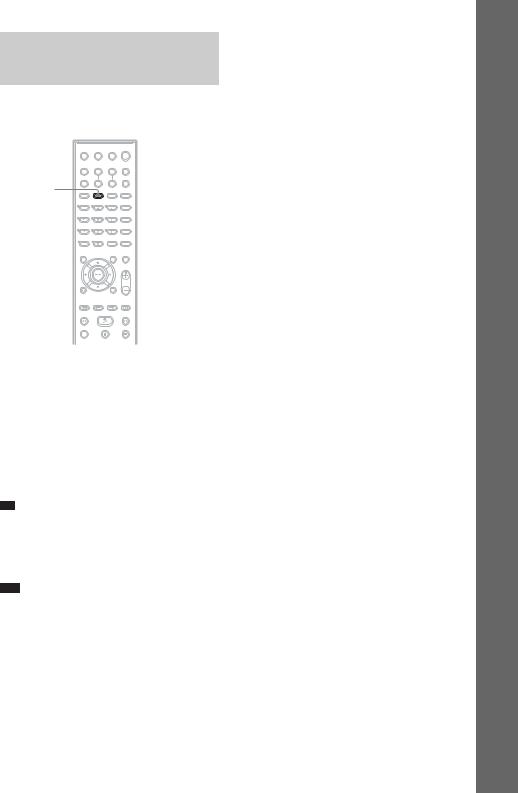
Selecting the Movie or Music Mode
You can choose a suitable sound mode for movies or music.
MOVIE/
MUSIC
Press MOVIE/MUSIC during playback.
Press MOVIE/MUSIC repeatedly until the mode you want lights up in the front panel display. The default setting is underlined.
•AUTO: selects the mode automatically to produce the sound effect depending on the disc.
•MOVIE: provides the sound for movies.
•MUSIC: provides the sound for music.
Tip
•When the movie or music mode is selected, “MOVIE” or “MUSIC” is displayed in the front panel display. When neither “MOVIE” or “MUSIC” is displayed in the front panel display, “AUTO” is selected.
Note
•You cannot operate these setup items when you connect headphones to the unit.
Operations Basic
25GB
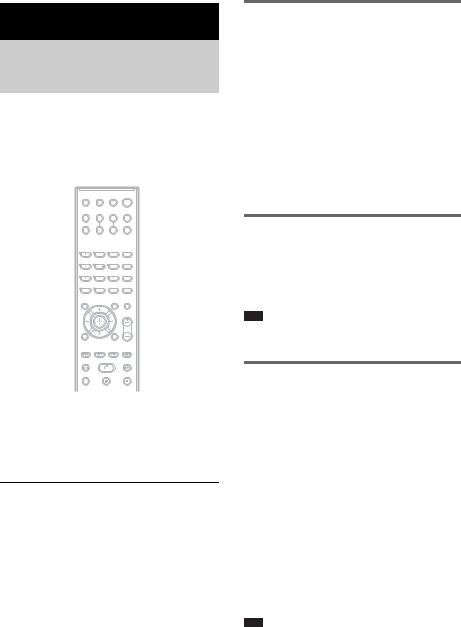
Sound Adjustments
Enjoying Surround Sound by Using Sound Field
You can take advantage of surround sound simply by selecting one of the system’s preprogrammed sound fields. They bring exciting and powerful sound of movie theaters into your home.
SOUND 



FIELD
Press SOUND FIELD.
Press SOUND FIELD repeatedly until the sound field you want appears in the front panel display.
All sound field
Sound field |
Display |
AUTO FORMAT DIRECT |
A.F.D. STD |
STANDARD |
|
|
|
AUTO FORMAT DIRECT |
A.F.D. MULTI |
MULTI |
|
|
|
Dolby Pro Logic |
PRO LOGIC |
|
|
Dolby Pro Logic II MOVIE |
PLII MOVIE |
|
|
Dolby Pro Logic II MUSIC |
PLII MUSIC |
|
|
2 CHANNEL STEREO |
2CH STEREO |
|
|
HEADPHONE |
HP 2CH |
2 CHANNEL STEREO |
|
|
|
HEADPHONE VIRTUAL |
HP VIRTUAL |
|
|
Automatic outputting of the original sound
x AUTO FORMAT DIRECT STANDARD
The auto decoding function automatically detects the type of audio signal being input (Dolby Digital, DTS, or standard 2 channel stereo) and performs the proper decoding if necessary. This mode presents the sound as it was recorded/encoded, without adding any effects (e.g. reverberation).
However, if there are no low frequency signals (Dolby Digital LFE, etc.), it will generate a low frequency signal for output to the subwoofer.
Outputting the sound from multiple speakers
x AUTO FORMAT DIRECT MULTI
This mode lets you enjoy audio playback of all types of discs from multiple speakers.
Note
•The sound is not output from multiple speakers depending on the source.
Outputting 2 channel sources like CDs by 5.1channel
x Dolby Pro Logic
Dolby Pro Logic produces five output channels from 2 channel sources. This mode performs Pro Logic decoding to the input signal and output to front, center, and surround speakers.
Meanwhile, the surround channel becomes monaural.
x Dolby Pro Logic II MOVIE/MUSIC
Dolby Pro Logic II produces five full-bandwidth output channels from 2 channel sources. This is done using an advanced, high-purity matrix surround decoder that extracts the spatial properties of the original recording without adding any new sounds or tonal colorations.
Note
•When the input signal is multi channel source, Dolby Pro Logic and Dolby Pro Logic II MOVIE/MUSIC are canceled and the multi channel source is output directly.
26GB

•When the bilingual broadcast sound is input, Dolby Pro Logic and Dolby Pro Logic II MOVIE/MUSIC are not effective.
Using only the front speaker and subwoofer
x 2 CHANNEL STEREO
This mode outputs the sound from the front left and right speakers and subwoofer. Standard 2 channel (stereo) sources completely bypass the sound field processing. Multi channel surround formats are downmixed to two channels.
This allows you to play any source using only the front left and right speakers and subwoofer.
Enjoying the surround sound by headphones
x HEADPHONE 2 CHANNEL STEREO
This mode outputs the sound from headphone L/ R. Standard 2 channel (stereo) sources completely bypass the sound field processing. Multi channel surround formats are downmixed to two channels.
x HEADPHONE VIRTUAL
This mode outputs the sound as surround from headphone L/R. This mode is effective only when a multi channel source is played.
To turn the surround effect off
Press SOUND FIELD repeatedly until “A.F.D. STD” or “2CH STEREO” appears in the front panel display.
Adjustments Sound
27GB
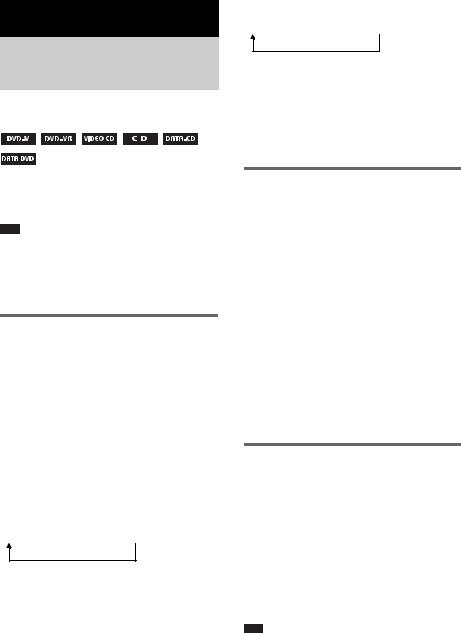
Various Functions for Playing Discs
Searching for a Particular Point on a Disc
(Scan, Slow-motion Play, Freeze
Frame)
Opposite direction
×2b t 1m t 2m t 3m
3m (DVD VIDEO/DVD-VR mode/DivX video*/ VIDEO CD only)
×2b (DVD VIDEO only)
*Except for United Kingdom and North American models.
With each press, playback speed becomes faster.
You can quickly locate a particular point on a disc by monitoring the picture or playing back slowly.
Note
•Depending on the DVD/DivX video*/VIDEO CD, you may not be able to do some of the operations described.
*Except for United Kingdom and North American models.
Locating a point quickly by playing a disc in fast forward or fast reverse (Scan)
(Except for JPEG)
Press  /m or M/
/m or M/ while playing a disc. When you find the point you want, press H to return to normal speed. Each time you press
while playing a disc. When you find the point you want, press H to return to normal speed. Each time you press  / m or M/
/ m or M/ during scan, the playback speed changes. With each press the indication changes as shown below. Actual speeds may differ with some discs.
during scan, the playback speed changes. With each press the indication changes as shown below. Actual speeds may differ with some discs.
Playback direction
×2B t 1M t 2M t 3M
3M (DVD VIDEO/DVD-VR mode/DivX video*/ VIDEO CD only)
×2B (DVD VIDEO/CD only)
*Except for United Kingdom and North American models.
Watching frame by frame (Slow-motion Play)
(DVD VIDEO, DVD-R, DVD-RW, DivX video*, VIDEO CD only)
*Except for United Kingdom and North American models.
Press  /m or M/
/m or M/ when the system is in pause mode. To return to normal playback speed, press H. Each time you press
when the system is in pause mode. To return to normal playback speed, press H. Each time you press /m or M/
/m or M/ during Slow-motion Play, the playback speed changes. Two speeds are available. With each press the indication changes as follows:
during Slow-motion Play, the playback speed changes. Two speeds are available. With each press the indication changes as follows:
Playback direction 2  y 1
y 1 
Opposite direction (DVD VIDEO only) 2  y 1
y 1 
Playing one frame at a time (Freeze Frame)
(DVD VIDEO, DVD-R, DVD-RW, DivX video*, VIDEO CD only)
*Except for United Kingdom and North American models.
When the system is in the pause mode, press 
 (step) to go to the next frame. Press
(step) to go to the next frame. Press 
 (step) to go to the preceding frame (DVD VIDEO/DVD-R/DVD-RW only). To return to normal playback, press H.
(step) to go to the preceding frame (DVD VIDEO/DVD-R/DVD-RW only). To return to normal playback, press H.
Note
•You cannot search for a still picture on a DVD-R/ DVD-RW in VR mode.
•For DATA CDs/DATA DVDs, this function works only for DivX video files (except for United Kingdom and North American models).
28GB
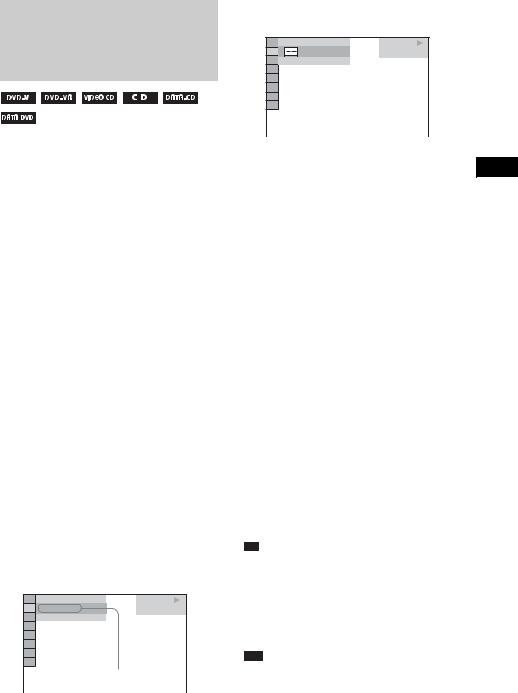
Searching for a Title/ Chapter/Track/Scene, etc.
You can search a DVD by title or chapter, and you can search a VIDEO CD/CD/DATA CD/ DATA DVD by track, index, or scene. As titles and tracks are assigned unique numbers on the disc, you can select the desired one by entering its number. Or, you can search for a scene using the time code.
1 Press  DISPLAY. (When playing a DATA CD/DATA DVD with JPEG image files, press
DISPLAY. (When playing a DATA CD/DATA DVD with JPEG image files, press  DISPLAY twice.)
DISPLAY twice.)
The Control Menu display appears.
2 Press X/x to select the search method.
The display will show different items depending on the disc.
 [TITLE], [TRACK], [SCENE]
[TITLE], [TRACK], [SCENE]
 [CHAPTER], [INDEX]
[CHAPTER], [INDEX]
 [TIME/TEXT]
[TIME/TEXT]
Select [TIME/TEXT] to search for a starting point by inputting the time code.
 [TRACK]
[TRACK]
 [ALBUM]
[ALBUM]
 [FILE]
[FILE]
Example: when you select  [CHAPTER]
[CHAPTER]
[** (**)] is selected (** refers to a number). The number in parentheses indicates the total number of titles, chapters, tracks, indexes, scenes, albums or files.
1 2 ( 2 7 ) |
|
|
1 8 ( 3 4 ) |
DVD VIDEO |
|
T |
1 : 3 |
2 : 5 5 |
Selected row
3 Press  .
.
[** (**)] changes to [– – (**)]. |
||
1 2 ( 2 7 ) |
|
|
|
( 3 4 ) |
DVD VIDEO |
T |
1 : 3 |
2 : 5 5 |
4 Press X/x or the number buttons to select the title, chapter, track, index, scene, etc., number you want to search for.
If you make a mistake
Cancel the number by pressing CLEAR, then select another number.
5 Press  .
.
The system starts playback from the selected number.
To search for a scene using the time code (DVD VIDEO and DVD-VR mode only)
1In Step 2, select  [TIME/TEXT].
[TIME/TEXT].
[T **:**:**] (playing time of the current title) is selected.
2Press  .
.
[T **:**:**] changes to [T --:--:--].
3Input the time code using the number buttons, then press  .
.
For example, to find the scene at 2 hours, 10 minutes, and 20 seconds after the beginning, just enter [2:10:20].
Tip
•When the Control Menu display is turned off, you can search for a chapter (DVD VIDEO/DVD-R/DVD- RW), track (VIDEO CD/CD), or file* (DATA CD/ DATA DVD (DivX video)) by pressing the number buttons and  .
.
*Except for United Kingdom and North American models.
Note
•You cannot search for a scene on a DVD+RW using the time code.
Discs Playing for Functions Various
29GB
